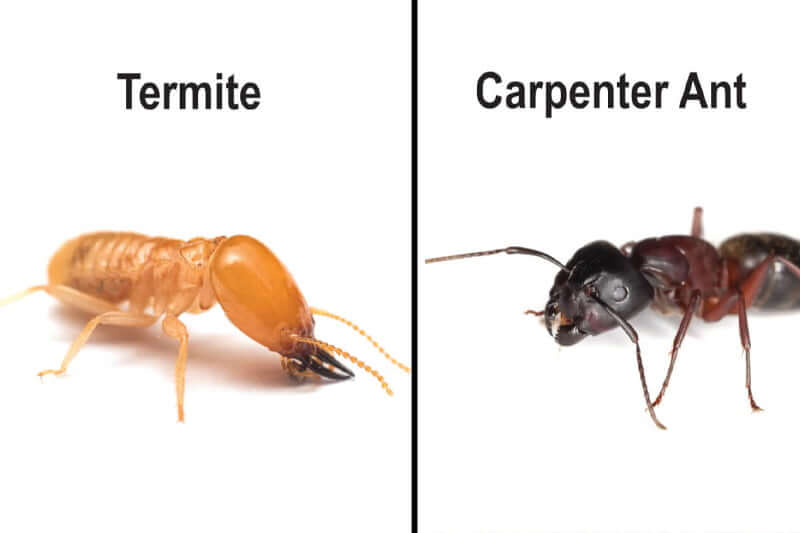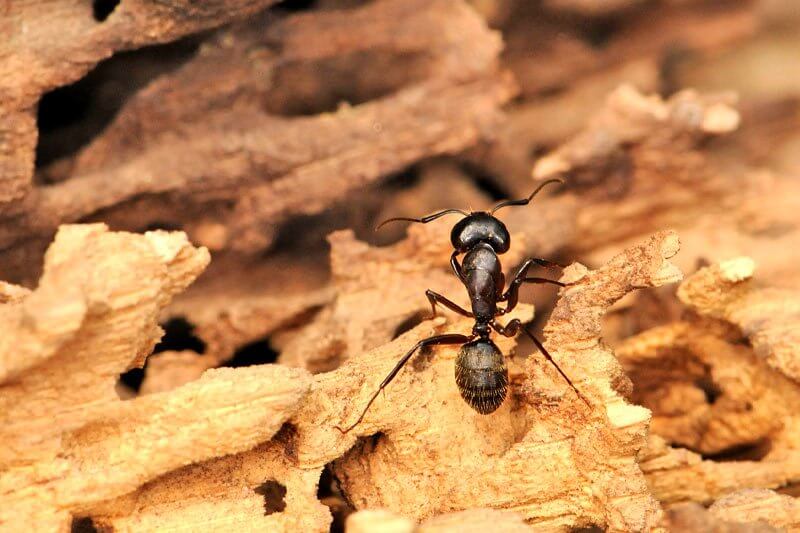For your pest control efforts to be effective, you need to know the difference between termites and carpenter ants. This is because while they both destroy wood, adopting a one-size-fits-all approach is bound to fail because these two pests are completely different.
Carpenter ants and termites differ in terms of appearance, behavior, feeding habits, and the way they design and build their nests. And while both of them are “silent destroyers”, detecting carpenter ants is generally easier than detecting termites.

Here is everything that you need to know about the difference between carpenter ants and termites.
You can distinguish between carpenter ants and termites by looking at their body shape and general appearance. This is because they have the following physical differences.
- Termites have broader waists than carpenter ants
- Carpenter ants have dark or reddish bodies while those of termites are generally creamy and light in color
- While carpenter ants have elbowed antennae that are segmented, termites have bead-like antennae that are straight.
Nests
While both termites and carpenter ants live in nests, their nests are very different.
They differ in terms of:
Texture. Termite nests consist of tunnels that are rough and rugged. Carpenter ants, on the other hand, create smooth tunnels that look like they have been properly finished.
Cleanliness. If you come across tunnels that have traces of mud and which seem unkempt, chances are that those are termite tunnels. This is because carpenter ant tunnels are usually clean and neat. They are often free of muddy streaks.
Organization. Carpenter ants are very intentional when it comes to creating their nests. They create elaborate galleries that seem well organized. Their tunnels also look thought-out and intentional.
Termites on the other hand create nests that seem less organized and intentional in terms of design.

Feaces
There is a significant difference between the feces of termites and carpenter ants. They differ in the following ways:
- Termite droppings mainly consist of wood since that is what termites primarily eat. On the other hand, carpenter ant droppings do not consist of wood since they never eat wood. Instead, they contain a mix of insects, carcasses, foodstuffs and other pests.
- Termite feces assume a uniform shape that is almost oval in shape. Unlike termites, ants produce droppings that are anything but uniform. This is because it usually contains a wide mix of substances.
- The location of the droppings also varies. While carpenter ants push their droppings out of their nest and to the entrance of their nest, termites do not. Termites usually hide their droppings. In some cases, they recycle them by using them as raw materials for creating mud tubes.
Wings
While both termites and carpenter ants have wings, their wings are different.
Size
Termites have two pairs of wings that are equally sized.
Carpenter ants don’t have wings that are of the same size. They have a pair of small wings and a pair of large wings.
Therefore, when you are trying to determine whether the wings in your house have been left by ants or termite swarmers, you should look at the size of the wings.
If all the wings are virtually the same in size, then you are likely dealing with a termite infestation. Those are wings that have been left behind by a termite swarm.
But if what you have is a mix of small and large wings, then you likely have a carpenter ant infestation.
Fragility
The other difference you notice has to do with the fragility of the wings. Termite wings are generally fragile and come off very easily. On the other hand, carpenter ant wings are generally very sturdy and don’t come off as easily.
Detection
Generally, carpenter ants are easier to detect than termites. This is because carpenter ants don’t feed on wood. Therefore, they have to look for food. In most cases, this means having to get out of their nests.
Termites are harder to detect because they can eat wood. Therefore, once they establish their nests, they have everything that they need to survive. They really don’t have to venture out of their nests in order to survive. Therefore, it is rare to see them roaming about your home.
Furthermore, even when they have to leave their colonies in search of food, they don’t crawl in the open. They build mud tubes that can shield them from detection.
Motivation behind destruction
Termites can digest cellulose. Therefore, termites eat wood mainly for sustenance. That is how they cause a lot of wood damage.
Do carpenter ants eat wood too? No, they don’t.
Carpenter ants chew wood, and cause most of their structural damage, with the aim of using the pieces to make their galleries and nests.
Therefore, carpenter ant damage is often limited to what it takes to create a nesting space. This is why wood shavings are a common sign of their presence.
Nest location
Both of them prefer to create their nests with wooden materials. However, where they choose to create their homes differ.
Carpenter ants prefer wet or damaged wood. As a result, you are likely to find them inhabiting damaged wood around windows and doors. Wood that is around bathtubs, sinks, chimneys or moist mulch in your garden is also a favorite target location for carpenter ant nests.
Subterranean termites, on the other hand, generally create their homes underground. Unlike carpenter ants, they don’t really discriminate on which wood to attack. And while they find wet wooden materials that are in contact with the ground irresistible, they can practically attack anything near their colony.
Ease of visibility
Carpenter ants are easier to see roaming about. This is mainly because they normally have to move out of their nest in order to find their food. Termites are less likely to be detected. This is because they often establish their colonies near or on their food source: wooden items or structures.
Therefore, you are more likely to run into a carpenter ant simply because it has to move around in order to get something to eat. A termite, on the other hand, has no reason to leave its home. And so the only time you are likely to see it is when its home has been disturbed.
Are there any similarities between termites and carpenter ants?
Yes, there are similarities between termites and carpenter ants. They are similar in the sense that they:
- Swarm during springtime
- Cause wood damage
- Are about the same size
- Have two sets of wings. When carpenter ants and termites swarm, they tend to leave them behind.
- They destroy property silently
- They build nests
- Have an oblong shape
Use this free service to find a qualified pest control expert near you
If you need professional pest control services, GoTreeQuotes.com offers a free service that quickly matches you with the top-voted local pest control experts in your area.
You can get 3 estimates fast by real certified pest control experts in your area in just 2 minutes. Here is how it works.
- You scroll to the top of the page and enter your Zip code.
- Answer questions about your pest problem
- Your details will be forwarded to three local experts.
- You will then receive a price estimate for the job and some friendly advice related to pest control solutions that will actually work for you.
IMPORTANT: There is no obligation to hire. This is a free tool and service to be used at your pleasure.











